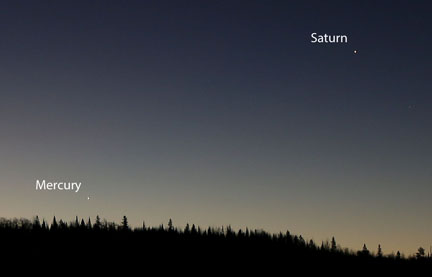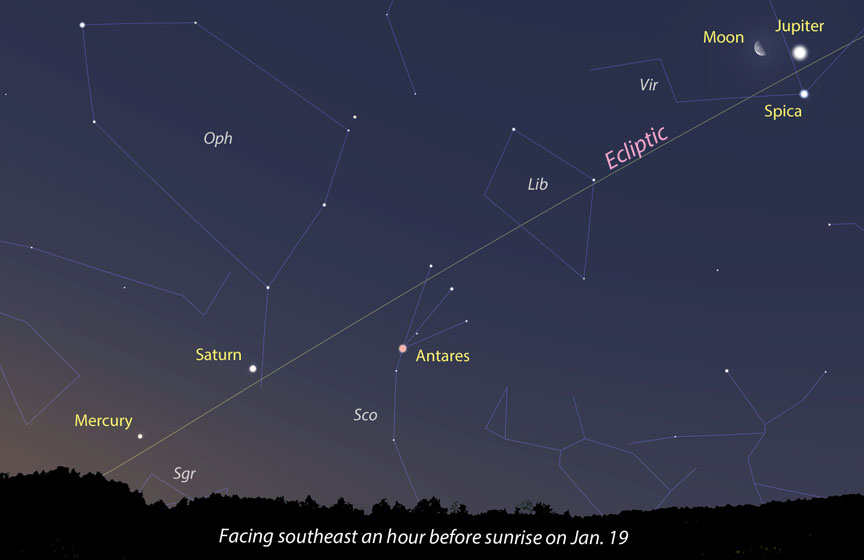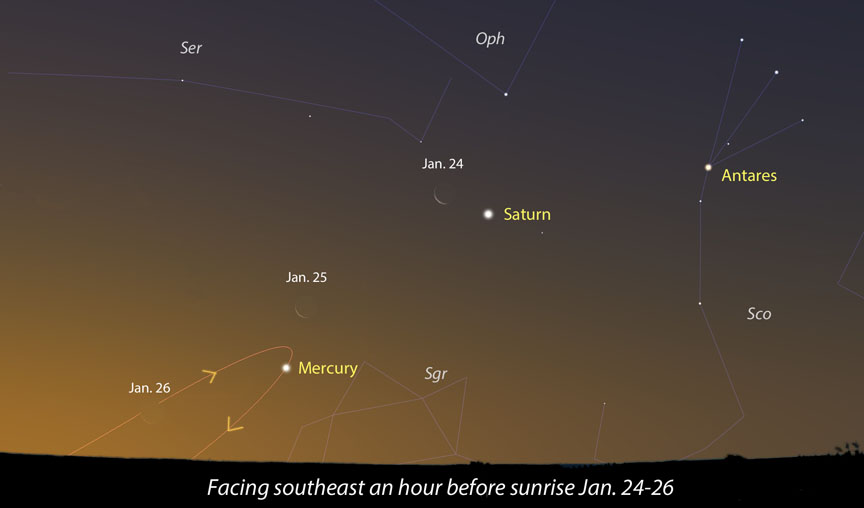Late sunrises make it easy to follow the parade of planets at dawn, including a nice apparition of Mercury this week and three successive lunar conjunctions.

Bob King
Before you know it, the Sun will come up at 5 a.m., making observing at dawn a serious loss-of-sleep experience. Now's the time to take advantage of winter's late sunrises — typically around 7:30 a.m. — to get out and look at your favorite planets or the Moon before a final cup of coffee and off to work.
The Moon slims to last-quarter phase this week and passes just 2.5° north of Jupiter on Thursday morning, January 19th. Few of us stay up late enough for a good look at the last-quarter Moon, when craters and hills cast their shadows to lunar east instead of west. After you've grown accustomed to first-quarter phase, seeing shading in reverse can be pleasantly disorienting.
Then there's the Jovian weather. A bright plume around longitude 190° (CM2) has recently appeared in the South Equatorial Belt (SEB), marking the start of a new SEB outbreak. Is the Great Red Spot still shrinking? Find out yourself Thursday morning, when it rotates squarely into view around 6:30 a.m. CST (7:30 EST, 5:30 MST, and 4:30 PST).
If all that doesn't entice you to drag out the scope, there's also this other little thing happening — Mercury's greatest western elongation.
The little planet with the big iron heart is having a decent morning apparition, reaching its greatest apparent distance west of the Sun on the 19th, the very same morning Jupiter, Spica, and the third-quarter Moon gather in conjunction high in the southern sky at dawn.

Map: Bob King, Source: Stellarium
When it comes to finding Mercury, Saturn gladly lends a hand. Like Mercury, the ringed planet recently made its dawn debut after solar conjunction. Saturn, being an outer planet, gradually rises into a dark sky, while little Mercury remains closely tethered to the Sun. Catch it now, when it's tugging at the end of its leash before Sol yanks it back into the searing light of day.
Saturn rises at 5:00 a.m., but isn't an easy catch until around 6:15–6:30 a.m., when dawn blues up the eastern sky. Look for it some 10°–15° high in the southeast, a fist and a half lower left of ruddy Antares in Scorpius. Once you've located Saturn, Mercury's a snap, provided you have a good horizon. Look about one fist to the lower left (farther east) of Saturn for a similarly bright star about an hour before sunrise. Yep, that's Mercury!

Diagram: Bob King, Source: Stellarium
Both planets currently shine around magnitude +0.6. I easily found Saturn from my observing site at +47° N on the 15th around 6:20 but had to wait until 6:45 (an hour before local sunrise) for Mercury to clear a line of distant trees. Both planets were obvious with the naked eye up till about 45 minutes before sunrise.
The duo was closest earlier this month with a minimum separation of about 7°. Since then, Saturn's hurried along to the west, a consequence of Earth's revolution around the Sun, with Mercury trying its best to catch up, ultimately an impossible task. They're currently 12° apart with their separation widening a degree a day until Mercury disappears in the solar glow in early February. That leaves about two weeks to catch this fleetest of planets before it reaches superior conjunction with the Sun in early March. After its solar baptism, Mercury will slip into the evening sky and put on a great show in late March–early April.

Map: Bob King, Source: Stellarium
But I'm getting ahead of myself. Be sure to mark your calendar for one week from now. On January 24th, the waning crescent Moon, just a few days before new, slices the evening sky next to Saturn. And on January 25th, the Moon glides some 5° north of Mercury. You may even want to take a picture of these conjunctions. To do so, you'll need a tripod and camera that can take a short time exposure. Use manual mode, focus on the lunar crescent, frame a scene, set the ISO or sensitivity to 400, set the lens aperture to f/4, and expose for 2–5 seconds.
Few people ever get to see Mercury because it requires a deliberate effort to track it down. Once you do, you'll be surprised — as I continually am — at how bright and easy it is. If you have school-aged kids, bundle them up and take them with you. They'll be up anyway and may appreciate sharing a few minutes of sky with Mom or Dad. Send them off on the bus with their heads full of planets.
 8
8








Comments
Anthony Barreiro
January 18, 2017 at 7:55 pm
Thanks Bob. Last week, between sunset Friday January 6 and dawn Saturday January 7, I scored a solar system bingo. We had a break in the rain and the sky was mostly clear all night. I observed Venus, Mars, Neptune (in the same low power telescope field with Venus), Uranus, the asteroid Vesta, and the Moon during the evening; then Jupiter and his four Galilean moons, Saturn, and Mercury before and during dawn -- all from my home in the Mission district of San Francisco (I had to go around to the other side of the block to see Saturn and Mercury). Venus was a lovely half moon through the telescope, and many passersby enjoyed seeing her. The air was very steady in the morning and Jupiter looked sharp -- the great red spot was visible. One guy on his way to work stopped to look. Turns out he has a small newtonian telescope himself, so we got to talk telescope.
You must be logged in to post a comment.
Anthony Barreiro
January 20, 2017 at 1:49 pm
Whoops, those dates are off by a week. It was Friday January 13 to Saturday January 14.
You must be logged in to post a comment.
Bob KingPost Author
January 22, 2017 at 9:13 pm
Anthony,
It's always a very special occasion to see ALL the planets plus the moon and Vesta to boot! Congrats on the achievement.
You must be logged in to post a comment.
January 20, 2017 at 2:50 pm
On january 6 I did see Saturn but needed binoculars to catch Mercury. Fog along the horizon prevented me from seeing both planets on January 12, but on the 16th I saw the planets on a fine clear morning. It was worth while rising an hour before my normal time to see them 🙂
You must be logged in to post a comment.
Bob KingPost Author
January 22, 2017 at 9:14 pm
Hi Jakob,
Glad to hear it. Thanks for sharing your observation!
You must be logged in to post a comment.
Graham-Wolf
January 23, 2017 at 6:55 pm
Thanks again Bob.
Nice pics and diagrams (as usual).
Nice views of Mercury (between recent violent storms!!).
A very nice waning crescent Moon this morning (naked eye) a few hours before dawn, followed later by Mercury (no... not Freddy)... hanging low near the Eastern horizon.
When 45p comes out of solar conjunction in a few weeks, folks will see Mercury low on the Eastern horizon... plus the comet of course! Two for the price of one. Keep up the good work, Bob. Regards from 46 South, NZ. Graham W. Wolf
You must be logged in to post a comment.
Bob KingPost Author
January 23, 2017 at 8:59 pm
Thanks Graham-Wolf! I always try to do a two-for-one or a three-for-one if I'm getting up before dawn. I'm sure I'll come up with something here in the N. hemisphere 🙂
You must be logged in to post a comment.
Bob
January 27, 2017 at 11:46 pm
Bob King...
I liked the Mercury phase diagrams. And the finder map of Jan. 24-26.
Bob Patrick
Kentucky
You must be logged in to post a comment.
You must be logged in to post a comment.